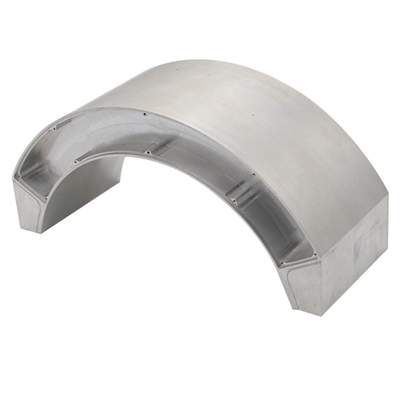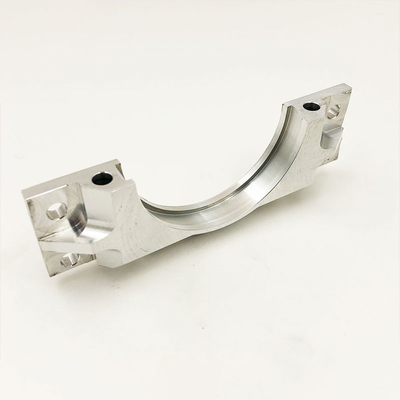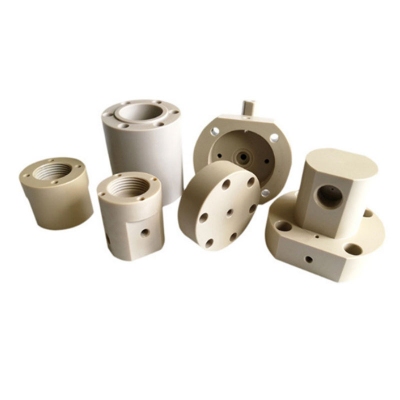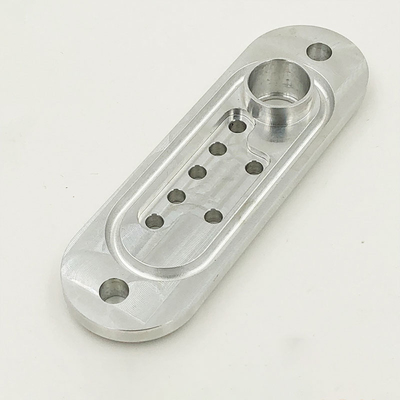Relationship between dimensional & shape tolerances and surface roughness
Relationship between dimensional tolerances, geometric tolerances, surface roughness
| From the numerical relationship between size, shape and surface roughness, it is not difficult to see that the numerical relationship of the three should be coordinated and coordinated during design. When the tolerance value is marked on the pattern, the roughness value of the same surface should be less than The shape tolerance value; and the shape tolerance value should be less than its position tolerance value; the position difference should be less than its dimensional tolerance value. Otherwise, it will cause trouble to the manufacturing. However, the most involved in the design work is how to deal with the relationship between dimensional tolerance and surface roughness and the relationship between various matching precision and surface roughness. |

In general, it is determined by the following relationship:
- 1. When the shape tolerance is 60% of the dimensional tolerance (medium relative geometric accuracy), Ra≤0.05IT;
- 2. When the shape tolerance is 40% of the dimensional tolerance (higher relative geometric accuracy), Ra≤0.025IT;
- 3. When the shape tolerance is 25% of the dimensional tolerance (high relative geometric accuracy), Ra≤0.012IT;
- 4. When the shape tolerance is less than 25% of the dimensional tolerance (super high relative geometric accuracy), Ra ≤ 0.15Tf (shape tolerance value).
The simplest reference value: the dimensional tolerance is 3-4 times the roughness, which is the most economical.
1) Numerical relationship between shape tolerance and dimensional tolerance
When the dimensional tolerance accuracy is determined, the shape tolerance has an appropriate value corresponding to the shape tolerance value of about 50% dimensional tolerance value; about 20% dimensional tolerance value of the instrument industry as the shape tolerance value; heavy industry A 70% dimensional tolerance value is used as the shape tolerance value. This can be seen. The higher the dimensional tolerance accuracy, the smaller the shape tolerance is to the dimensional tolerance ratio. When designing the dimensioning and shape tolerance requirements, except for special cases, when the dimensional accuracy is determined, the 50% dimensional tolerance value is generally used as the shape tolerance value. This is beneficial both to manufacturing and to ensuring quality.
2) Numerical relationship between shape tolerance and position tolerance
There is also a relationship between shape tolerance and position tolerance. From the cause of the formation of the error, the shape error is caused by machine vibration, tool vibration, spindle runout, etc.; the position error is due to the non-parallel of the machine guide rails, the tool clamping is not parallel or non-vertical, the clamping force acts, etc. Therefore, from the definition of the tolerance band, the position error is the shape error of the surface to be tested. If the parallelity error contains the flatness error, the position error is much larger than the shape error. Therefore, in the general case, when no further requirements are given, the position tolerance is given and the shape tolerance is no longer given. When there are special requirements, the shape and position tolerance requirements can be marked at the same time, but the shape tolerance value of the label should be less than the position tolerance value marked. Otherwise, the parts cannot be manufactured according to the design requirements during production.
3) Relationship between shape tolerance and surface roughness
Although there is no direct relationship between shape error and surface roughness in terms of numerical values and measurement, there is a certain proportional relationship between the two under certain processing conditions. According to experimental research, the surface roughness accounts for shape tolerance in general accuracy. 1/5 to 1/4. It can be seen that in order to ensure the shape tolerance, the maximum allowable value of the corresponding surface roughness height parameter should be appropriately limited.
Shape tolerance selection
1) Selection of geometric tolerance items
The functions of the integrated control project should be fully utilized to reduce the geometrical tolerance items and the corresponding geometric error detection items given on the drawings.
Under the premise of meeting the functional requirements, the project with simple measurement should be selected. For example, coaxial tolerances are often replaced by radial circle runout tolerances or radial circle runout tolerances. However, it should be noted that the radial circle runout is a combination of the coaxiality error and the cylindrical surface shape error. Therefore, when it is replaced, the jitter tolerance value given should be slightly larger than the coaxial tolerance value, otherwise it will be too strict.
2) Choice of tolerance principle
According to the functional requirements of the measured elements, the functions of tolerance should be fully utilized and the feasibility and economy of adopting the tolerance principle should be adopted.
The principle of independence is used for dimensional accuracy and accuracy of position and position accuracy. It needs to meet the requirements separately, or there is no connection between the two, to ensure motion accuracy, sealing, and no tolerance.
Inclusion requirements are mainly used in applications where strict coordination is required.
The largest entity is required for the central element and is typically used where the fitting requirements are assemblable (no mating requirements).
The minimum physical requirements are primarily used where it is necessary to ensure part strength and minimum wall thickness.
The reversible requirement is combined with the maximum (minimum) entity requirement, which makes full use of the tolerance zone, expands the range of the actual size of the measured component, and improves the efficiency. Can be used without affecting the performance.
Selection of benchmark elements
1) Selection of reference parts
- (1) Select the joint surface where the parts are positioned in the machine as the reference part. For example, the bottom plane and side of the case, the axis of the disk part, the support journal or the support hole of the rotary part, and the like.
- (2) The reference element should have sufficient size and rigidity to ensure stable and reliable positioning. For example, combining two or more axes that are further apart into a common reference axis is more stable than a reference axis.
- (3) Select a surface with a relatively precise surface as the reference part.
- (4) Make the assembly, processing and testing benchmarks as uniform as possible. In this way, the error caused by the non-uniformity of the reference can be eliminated, and the design and manufacture of the jig and the measuring tool can be simplified, and the measurement is convenient.
2) Determination of the number of benchmarks
In general, the number of references should be determined based on the orientation of the tolerance project and the positioning geometry requirements. Most of the orientation tolerances are for one datum, while the positioning tolerance requires one or more datums. For example, for parallelism, perpendicularity, and coaxiality tolerance items, generally only one plane or one axis is used as the reference element; for the positional tolerance item, the positional accuracy of the hole system needs to be determined, and two or three may be used. Benchmark elements.
3) Arrangement of the benchmark order
When two or more reference elements are selected, the order of the reference elements is clarified and written in the tolerance grid in the first, second, and third order. The first reference element is the primary and the second reference element is the second. .
Shape tolerance value selection
General principle: Select the most economical tolerance value while satisfying the function of the part.
◆ According to the functional requirements of the parts, considering the economics of the machining and the structure and rigidity of the parts, the tolerance values of the elements are determined according to the table. And consider the following factors:
◆ The shape tolerance given by the same element should be less than the position tolerance value;
◆ The shape tolerance value of the cylindrical part (except the straightness of the axis) should be less than the dimensional tolerance value; if the same plane, the flatness tolerance value should be less than the parallelism tolerance value of the plane to the reference.
◆ Parallelism tolerance values should be less than their corresponding distance tolerance values.
◆ Approximate proportional relationship between surface roughness and shape tolerance: Generally, the Ra value of surface roughness can be taken as the shape tolerance value (20%~25%).
◆ For the following cases, taking into account the difficulty of processing and the influence of other factors besides the main parameters, under the requirements of the function of the parts, appropriately reduce the selection of 1 to 2:
- ○ hole relative to the axis;
- ○ slender large shafts and holes; larger shafts and holes;
- ○ The surface of the part with a large width (greater than 1/2 length);
- ○ Line-to-line and line-to-face parallelism and perpendicularity tolerances with respect to face to face.
Shape and unfilled tolerance
In order to simplify the drawing, the shape and position accuracy can be guaranteed by the general machine tool processing, and it is not necessary to inject the geometrical tolerance on the drawing. The shape and the unfilled tolerance are executed according to the provisions of GB/T1184-1996. The general contents are as follows:
- (1) Three tolerance levels of H, K, and L are specified for unmarked straightness, flatness, verticality, symmetry, and circular runout.
- (2) The unroundedness tolerance value is equal to the diameter tolerance value, but cannot be greater than the unfilled tolerance value of the radial circle runout.
- (3) The unoccupied cylindricity tolerance value is not specified, and is controlled by the roundness tolerance of the element, the straightness of the prime line, and the injection or unfilled tolerance of the parallelism of the relative prime line.
- (4) The unparallelism tolerance value is equal to the larger of the dimensional tolerance between the measured element and the reference element and the shape tolerance of the measured element (straightness or flatness), and takes two The longer of the elements is used as a benchmark.
- (5) The unconformed coaxiality tolerance value is not specified. If necessary, the unfilled tolerance value of the coaxiality is equal to the unfilled tolerance of the circular runout.
- (6) The tolerance values of unlineed contour, surface profile, inclination, and position are all controlled by the injected or unfilled linear dimensional tolerance or angular tolerance of each element.
- (7) The un-noted full-bounce tolerance value is not specified.
The pattern representation of the shape of the unfilled tolerance value
If the unfilled tolerance value specified in GB/T1184-1996 is used, the standard and grade code shall be indicated in the title column or technical requirements. : "GB/T1184-K".
The working tolerances of the “Tolerance Principle according to GB/T 4249” are not marked on the drawings and shall be carried out in accordance with the requirements of “GB/T 1800.2-1998”.
Link to this article: Relationship between dimensional & shape tolerances and surface roughness
Reprint Statement: If there are no special instructions, all articles on this site are original. Please indicate the source for reprinting:https://www.cncmachiningptj.com/,thanks!
 PTJ® provides a full range of Custom Precision cnc machining china services.ISO 9001:2015 &AS-9100 certified. 3, 4 and 5-axis rapid precision CNC machining services including milling, turning to customer specifications,Capable of metal & plastic machined parts with +/-0.005 mm tolerance.Secondary services include CNC and conventional grinding, drilling,die casting,sheet metal and stamping.Providing prototypes, full production runs, technical support and full inspection.Serves the automotive, aerospace, mold&fixture,led lighting,medical,bicycle, and consumer electronics industries. On-time delivery.Tell us a little about your project’s budget and expected delivery time. We will strategize with you to provide the most cost-effective services to help you reach your target,Welcome to Contact us ( [email protected] ) directly for your new project.
PTJ® provides a full range of Custom Precision cnc machining china services.ISO 9001:2015 &AS-9100 certified. 3, 4 and 5-axis rapid precision CNC machining services including milling, turning to customer specifications,Capable of metal & plastic machined parts with +/-0.005 mm tolerance.Secondary services include CNC and conventional grinding, drilling,die casting,sheet metal and stamping.Providing prototypes, full production runs, technical support and full inspection.Serves the automotive, aerospace, mold&fixture,led lighting,medical,bicycle, and consumer electronics industries. On-time delivery.Tell us a little about your project’s budget and expected delivery time. We will strategize with you to provide the most cost-effective services to help you reach your target,Welcome to Contact us ( [email protected] ) directly for your new project.

- 5 Axis Machining
- Cnc Milling
- Cnc Turning
- Machining Industries
- Machining Process
- Surface Treatment
- Metal Machining
- Plastic Machining
- Powder Metallurgy Mold
- Die Casting
- Parts Gallery
- Auto Metal Parts
- Machinery Parts
- LED Heatsink
- Building Parts
- Mobile Parts
- Medical Parts
- Electronic Parts
- Tailored Machining
- Bicycle Parts
- Aluminum Machining
- Titanium Machining
- Stainless Steel Machining
- Copper Machining
- Brass Machining
- Super Alloy Machining
- Peek Machining
- UHMW Machining
- Unilate Machining
- PA6 Machining
- PPS Machining
- Teflon Machining
- Inconel Machining
- Tool Steel Machining
- More Material





